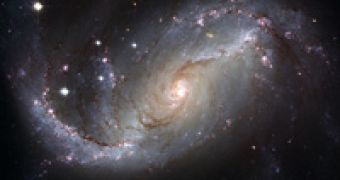With the help of the Hubble Space Telescope, astronomers have produced remarkable images of a spiral galaxy called NGC 1672 - a distant relative of our own Milky Way, only sexier - providing a high definition view of the galaxy's large bar, its fields of star-forming clouds and dark bands of interstellar dust.
When I say "distant," I'm talking in terms of literal distance: NGC 1672 is 60 million light-years away, in the southern constellation Dorado. And when it comes to the galaxy's relationship to our home galaxy, astronomers see some interesting similarities as well as differences.
Like the Milky Way, NGC 1672 has four major spiral arms that are linked to a straight "bar" of stars and dust. NGC 1672 is just a little smaller than the Milky Way, and both galaxies are apparently anchored at their cores by supermassive black holes.
All this leads Joe Liske, a German astronomer at the European Southern Observatory, to call NGC 1672 a "sister galaxy" in a video podcast presented by the European Space Agency's Hubble Information Center.
But unlike the relatively mild-mannered Milky Way, NGC 1672's nucleus is thought to be ablaze with activity, although that blaze is clouded by veils of dust.
Might our galaxy light up in the same way, or is it finished with its hot-blooded phase? That's one of the big questions - and one of the reasons why astronomers are interested in active galaxies like NGC 1672 (which is technically classified as a Seyfert galaxy, after the astronomer, Carl Keenan Seyfert, who studied a family of galaxies with active nuclei extensively in the 1940s).
The energy output of these nuclei can sometimes outshine their host galaxies. The active galaxy family includes the exotically named quasars and blazars. Although each type has distinctive characteristics, they are thought to be all driven by the same engine - supermassive black holes - but are viewed from different angles.
They're also curious about the distinction between barred and non-barred spiral galaxies. The central galactic bars may help channel gas from the outlying disk into the nucleus, sparking new waves of star formation - but what are the dynamics of that process? Scientists believe that the bars are relatively short-lived, recurring phenomena - but where do they fit in the cycle of galactic evolution?
These are more questions waiting to be answered, pending future observations and studies.

 14 DAY TRIAL //
14 DAY TRIAL //